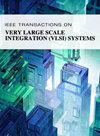AES系统中具有自回收10T-SRAM单元的全阵列布尔逻辑CIM宏
IF 3.1
2区 工程技术
Q2 COMPUTER SCIENCE, HARDWARE & ARCHITECTURE
IEEE Transactions on Very Large Scale Integration (VLSI) Systems
Pub Date : 2025-03-29
DOI:10.1109/TVLSI.2025.3572140
引用次数: 0
摘要
内存计算(CIM)减轻了在处理器和内存之间传输大量数据的需要,显著降低了延迟和能耗,是解决冯·诺依曼瓶颈问题的一种很有前途的新计算架构。本文提出了一种由自循环10T静态随机存取存储器(SRAM)单元组成的CIM阵列结构,可以实现正交数据写入,并对整个阵列进行多次布尔逻辑运算。自循环和全阵列激活特性非常适合加速各种数据处理算法,如高级加密标准(AES)。采用55纳米CMOS技术实现了4kb SRAM,以验证该设计的有效性。与其他最先进的架构相比,所提出的CIM宏的吞吐量和工作频率分别增加到843 GOPS/kb(2.64\倍$)和823.7 MHz(2.6\倍$)。能效达到246.9 TOPS/W。应用于AES时,能耗比非自循环的数字CIM架构低35.77%。本文章由计算机程序翻译,如有差异,请以英文原文为准。
Full-Array Boolean Logic CIM Macro With Self-Recycling 10T-SRAM Cell for AES Systems
Computing in memory (CIM), which alleviates the need to transfer a large amount of data between processor and memory, significantly reducing latency and energy consumption, is a promising new computing architecture for addressing the von Neumann bottleneck problem. This article proposes a CIM array structure composed of self-recycling 10T static random access memory (SRAM) cells, which can realize orthogonal data writing, and multiple Boolean logical operations for the entire array. The self-recycling and full-array activation characteristics are extremely suitable for accelerating diverse data processing algorithms such as the Advanced Encryption Standard (AES). A 4-kb SRAM is implemented in 55-nm CMOS technology to verify the effectiveness of the design. Compared with other state-of-the-art architectures, the throughput and the operating frequency of the proposed CIM macro are increased to 843 GOPS/kb ( $2.64\times $ ) and 823.7 MHz ( $2.6\times $ ), respectively. The energy efficiency reaches 246.9 TOPS/W. When applied to the AES, the energy consumption is 35.77% less than the digital CIM architecture that is not self-recycling.
求助全文
通过发布文献求助,成功后即可免费获取论文全文。
去求助
来源期刊
CiteScore
6.40
自引率
7.10%
发文量
187
审稿时长
3.6 months
期刊介绍:
The IEEE Transactions on VLSI Systems is published as a monthly journal under the co-sponsorship of the IEEE Circuits and Systems Society, the IEEE Computer Society, and the IEEE Solid-State Circuits Society.
Design and realization of microelectronic systems using VLSI/ULSI technologies require close collaboration among scientists and engineers in the fields of systems architecture, logic and circuit design, chips and wafer fabrication, packaging, testing and systems applications. Generation of specifications, design and verification must be performed at all abstraction levels, including the system, register-transfer, logic, circuit, transistor and process levels.
To address this critical area through a common forum, the IEEE Transactions on VLSI Systems have been founded. The editorial board, consisting of international experts, invites original papers which emphasize and merit the novel systems integration aspects of microelectronic systems including interactions among systems design and partitioning, logic and memory design, digital and analog circuit design, layout synthesis, CAD tools, chips and wafer fabrication, testing and packaging, and systems level qualification. Thus, the coverage of these Transactions will focus on VLSI/ULSI microelectronic systems integration.

 求助内容:
求助内容: 应助结果提醒方式:
应助结果提醒方式:


